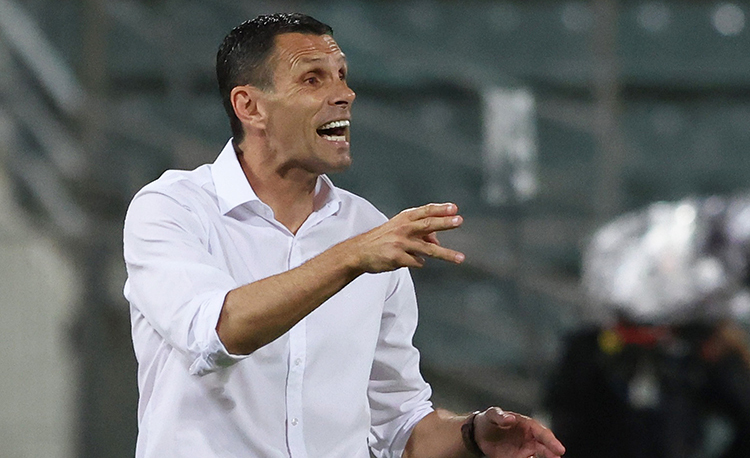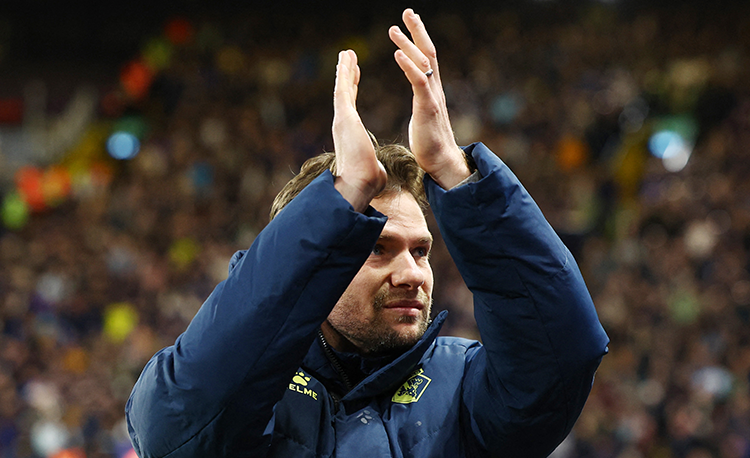This is a session we use to train our players to transition to defence after losing the ball. In doing so, we encourage them to react quickly and to recover into their defensive positions.
| Area | Up to full pitch |
| Equipment | Balls, bibs, cones, 1 small goal, 2 full size goals |
| No. of Players | Up to 20 players + 2 goalkeepers |
| Session Time | Warm-up: 5mins Wave game: 18mins Defending runs: 20mins 11v11 defensive transition: 15mins |
This is a session we use to train our players to transition to defence after losing the ball. In doing so, we encourage them to react quickly and to recover into their defensive positions.
As a team, we adopt a style of possession-play that is focused on looking after the ball. As a consequence, this has the risk of leaving spaces that the opposition can exploit on transition, so we have to ensure that our players react quickly after losing the ball.
Nowadays, much more attention is given to transitions in play and it’s very important to make the training of transitions as realistic as possible.
As a team we look to keep possession, so the reaction after losing the ball is very important to us.
The players like this session because it is highly competitive and features plenty of ball contact and numerous game-related actions. We would run this session during pre-season, or in specific weeks when we have plenty of time between games.
“As a team we look to keep possession, so the reaction after losing the ball is very important to us”
WARM-UP
We set up a playing area of 30x30 yards. A target goal is positioned on one corner and we’re using nine outfield players, with groups of three lining up at each of the three remaining corners. A cone is placed a few yards from the corner that is diagonally opposite the target goal, as shown.
The ball starts with the player at the front of the first group of three. The starting player passes the ball along the outside of the area to the player at the front of the second group, before receiving it back. One player from the second group then drops to the outside cone to receive a pass and then plays the ball to the first player in the third group, as shown [1a].
[1a]

- The starting player passes the ball along the outside of the area to the player at the front of the second group, before receiving it back
- One player from the second group drops to the outside cone to receive a pass before playing it to the first player in the third group
The player receives the ball and dribbles along the top side of the box to attack the mini goal and score. The first player from the first group makes a run to passively defend against the attacker, pressuring the dribbling player without actually tackling. Each of the active players then joins the back of the queue at the next corner, as shown [1b].
[1b]

- The receiving player attacks the target goal
- The starting player goes to passively defend against the attacker, pressuring the dribbler without tackling
- The dribbler finishes by scoring in the target goal
- Each of the active players then joins the back of the next queue
“The first player from the first group goes to passively defend against the attacker, pressuring the dribbling player without tackling”
After two and a half minutes, the goal is moved so the drill can be performed the other way and the drill runs for another two and a half minutes.
WAVE GAME
We create a playing area made up of two penalty areas with a full size goal and a goalkeeper at each end. We’re using seven outfield players split into four reds and three blues. Three blue players start next to one goal and four reds start next to the other goal.
A red player starts with the ball and passes to a blue player, who runs onto it and makes an attempt on goal, as shown [2a].
[2a]

- A red player starts with the ball and passes it to a blue player
- The blue player runs onto the ball and has an attempt on goal
Two reds then enter the pitch with a ball between them, creating a 2v1. They use their overload to get past the opposition defender and then they attempt to score in the goal, as shown [2b].
[2b]

- After the first blue attack is dead, two reds enter the pitch with a ball between them, creating a 2v1 against the blue player
- The reds use their overload to get past the opposition defender and then they attempt to score in the goal
Two more blue players enter the pitch with a ball, joining the player who defended the previous attack to create a 3v2 attack, as shown [2c].
[2c]

- Two more blue players enter the pitch with a new ball, joining the player who defended the previous attack. They create a 3v2 attack
- When the ball is dead the final two red players enter the pitch with a ball, creating a 4v3 attack
Following an attempt on goal by the blues, the final two red players enter the pitch with a ball, creating a 4v3 attack.
We repeat this practice in blocks of six minutes.
DEFENDING RUNS
We create a playing area of 65x50 yards with a full size goal and a goalkeeper at one end. We’re using 13 outfield players split into a blue team of six who are defending the goal against a red attacking team of seven. The blues are set up in a 4-1-1 formation, with the player furthest forward starting on the end line. The reds are set up in a 2-2-3 formation. A blue defender starts with the ball, running to the end line. The rest of the blue team moves as if attacking. When the blue defender reaches the end line, the coach plays a second ball to the red team, as shown [3a].
[3a]

- The reds are set up in a 2-2-3 formation
- The blues are set up in a 4-1-1 formation, with the player furthest forward starting on the end line
- A blue defender starts with the ball and dribbles to the end line
- The rest of the blue team move as if attacking
- When the blue defender reaches the end line, the coach plays a second ball to the red team
The red team then attack the goal as quickly as possible.
The blue defender who reached the end line now sprints back to support the blue team in defence, along with the blue team’s other attacker, as shown [3b].
[3b]

- The reds receive the second ball from the coach, creating a transition. They then attack the goal as quickly as possible
- The blue defender who reached the end line now sprints back to support the blue team in defence, along with the blue team’s other attacker
- Once a goal has been scored by the reds, or if the ball goes out of play, the game starts again
Once a goal has been scored by the reds, or if the ball goes out of play, the game starts again, this time with a different blue defender running to the end line. After 10 minutes, the coach rotates the players and the reds become the defending team.
11v11 DEFENSIVE TRANSITION
We set up on a full pitch with a goal and a goalkeeper at each end. We’re using 20 outfield players split into two teams of 11 including keepers. The blues start with the ball and play out of defence, building an attack from the back. At various points, based on the position of the attacking team, the coach will blow a whistle and then plays a new ball to the red defending team, creating a transition.
The teams must leave the first ball in play and focus on attacking with the new ball, as shown [4].
[4]

- The blues start with the ball and play out of defence, building an attack from the back
- The coach blows a whistle and then plays a new ball to the defending team, creating a transition
- Both teams must leave the first ball and focus on attacking with the new ball
COACHING POINTS
What are the key things to look for?
We are looking for reactions after losing the ball. We are also looking for proper recovery runs and for players making defending decisions on how to delay the opposition attack to give the rest of the team the time to recover from offensive positions and help defend our goal. There are numerous different situations that are created in this session that give the coaches the opportunity to explain how to deal with these defensive situations.
What are the typical mistakes players might make and how do I avoid them?
Typical mistakes include players moaning, stopping and not reacting after losing the ball, so we make sure that we recreate as many situations as possible where the players are obliged to react or make recovery runs that help the team to get in shape after losing the ball.
Related Files
Editor's Picks
Attacking transitions
Deep runs in the final third
Using the goalkeeper in build-up play
Intensive boxes drill with goals
Penetrating the final third
Creating and finishing
My philosophy
Pressing initiation
Compact team movement
Coaches' Testimonials

Alan Pardew

Arsène Wenger

Brendan Rodgers

Carlos Carvalhal

José Mourinho

Jürgen Klopp

Pep Guardiola

Roy Hodgson

Sir Alex Ferguson

Steven Gerrard
Coaches' Testimonials

Gerald Kearney, Downtown Las Vegas Soccer Club

Paul Butler, Florida, USA

Rick Shields, Springboro, USA

Tony Green, Pierrefonds Titans, Quebec, Canada
Join the world's leading coaches and managers and discover for yourself one of the best kept secrets in coaching. No other training tool on the planet is written or read by the calibre of names you’ll find in Elite Soccer.
In a recent survey 92% of subscribers said Elite Soccer makes them more confident, 89% said it makes them a more effective coach and 91% said it makes them more inspired.
Get Monthly Inspiration
All the latest techniques and approaches
Since 2010 Elite Soccer has given subscribers exclusive insight into the training ground practices of the world’s best coaches. Published in partnership with the League Managers Association we have unparalleled access to the leading lights in the English leagues, as well as a host of international managers.
Elite Soccer exclusively features sessions written by the coaches themselves. There are no observed sessions and no sessions “in the style of”, just first-hand advice delivered direct to you from the coach.









